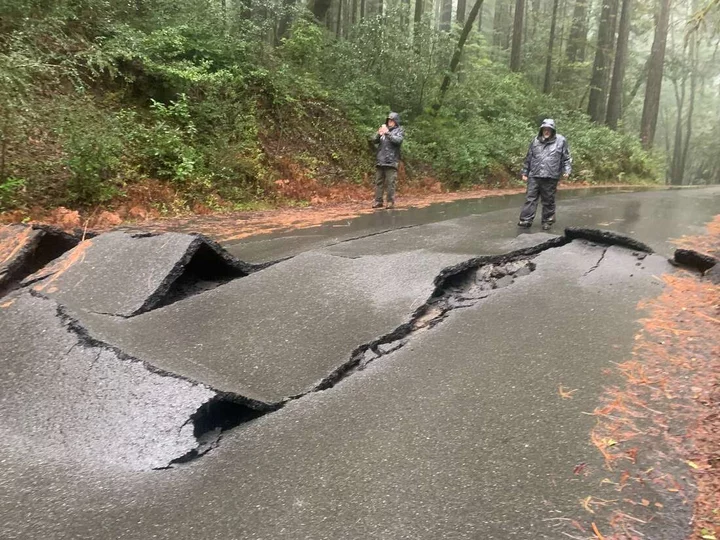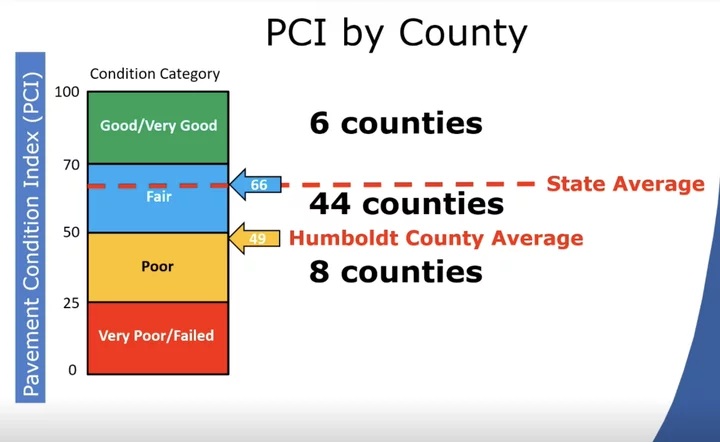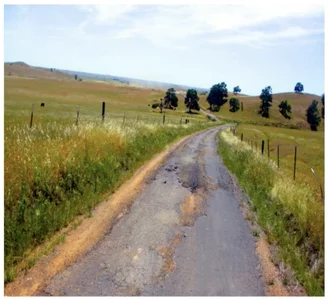Mattole Road was one of many Humboldt County roads to suffer extreme damage during recent winter storms. Photo: California State Parks
###
Humboldt County’s roads are in bad shape, and without additional funding for repairs they’re only going to get worse.
Every four years, the county is tasked with updating its Pavement Management Program (PMP) which, essentially, documents the condition of the county’s roads and helps guide the decision-making process for choosing the most cost-effective maintenance strategies. To develop the PMP, roads are broken into segments and rated through the Pavement Condition Index (PCI) on a scale of zero to 100, with zero being the worst and 100 being the best. During the county’s last PMP review in 2017, the county’s overall road system ranked at 55 and was considered to be in “fair condition.”
“Now we are down to 49, which is in the ‘poor condition’ [range],” Public Works Director Tom Mattson told the Board of Supervisors during Tuesday’s meeting. “We’re off the cliff. We’re going to rapidly deteriorate from here if we don’t get additional funding to stop this from happening.”
Screenshot
Once a road is newly paved, it’s pretty easy to keep it in the “very good” to “good” range with minimal maintenance costs such as slurry and chip seals, but as they deteriorate and dip into the “fair” range, the cost of repairs grows exponentially.
Mattson reiterated that the PCI is an average of the county’s entire road system. “So yes, we do have roads like this,” he said, gesturing to the image to the right. “We also have some very good roads, but it’s the average overall that is bringing our whole system down. … But over 50 percent of our roads are poor or failed condition.”
It’s going to cost over half a billion dollars over the next 10 years to get the county’s road system up to an index of 70, which would indicate an overall good system, Mattson said. To maintain the existing PCI of 49, the county would still need an additional $343.8 million in the same time period. If there are no additional funds allocated for road maintenance, the county’s overall PCI is projected to “fail” and drop to 25.
Where will that funding come from? Mattson outlined several options for the board, including a general sales tax, a dedicated sales tax or a parcel tax which would all have to go to the ballot for voter approval. The funding could also come from the county’s General Fund, but Mattson said that’s “not something I would want to rely on,” adding that the county roads need a “dedicated funding source that could be relied on and planned for.”
“The General Fund [has] ups and downs,” he continued. “That’s very difficult, especially with years like this where everybody’s having to tighten their belts. It’s very difficult to ask for roads for General Fund when you’re cutting other core services.”
Measure Z has proved to be an adequate funding source in years past, but this year “it simply isn’t enough,” Mattson said. Just last week, the Board of Supervisors learned that Measure Z, the county’s half-cent sales tax for maintenance and enhancement of public safety and essential services, is expected to bring in $1.8 million less than staff’s estimate for the current fiscal year.
“This year there was very little funding available for anybody to compete,” Mattson said. “[Measure Z] is really not for long-term road maintenance, [and] our problem is long-term road maintenance.”
The last option Mattson suggested was to reduce the county’s maintained road system mileage. “But that’s not an easy thing to do,” he said. “The county looked into it years ago and got a significant amount of blowback from the public. While we would lose $417 per mile that is very, very little based on what we need to maintain those roads.”
Whichever option the board chooses, Mattson recommended the formation of an ad hoc committee to oversee the process and make recommendations for future funding priorities.
Turning to the board for discussion, Fifth District Supervisor and Board Chair Steve Madrone said he had recently come across some data that found California drivers spend approximately $900 per year on vehicle maintenance related to road damage.
“For instance, you hit the pothole and there goes your alignment,” he said. “As your alignment goes out and the wear and tear on your tires goes down. Suddenly your brand new four tires that are nicely matched become two tires and then one tire that’s wearing out really fast. … If you think about a half-cent sales tax and [the cost of repairs], it is clearly far less to spend on sales tax as a person than to pay out this money on your car repairs.”
Second District Supervisor Michelle Bushnell asked what reducing the county’s maintained road system would look like and how Public Works would navigate the selection process.
“That looks at how many people are using the road, what kind of access it serves … if it ends or if it goes into a last property,” Mattson explained. “Once a road goes out of the system, people can do things like starting putting up gates and other things. It would involve developing a criteria that we would be able to go through and apply to [each] road. It would not be some kind of random ‘I don’t like you, I’m taking your road out of the system.’ … It would be us basically scientifically coming up with a justification and seeing if the public could support it.”
First District Supervisor Rex Bohn recalled a time “in the ‘90s” when the county decided to abandon several roads in the First District “and the proverbial manure spreader hit the fan,” he said. “It’s not going to work.”
“I hate to say it, but I think the option of a sales tax is what we’re going to have to look at,” Bohn continued. “[If] you make a commitment with five people on board that this money will be spent on roads, it’s going to be hard – even if we just do a general sales tax – that’s gonna be pretty hard to override.”
Fourth District Supervisor Natalie Arroyo noted that during her time on the Eureka City Council, the City of Eureka focused “on maintaining arterials, as roads with higher volumes … [are] the most used and critical.” (In this case, an “arterial road” refers to a high-traffic road, such as Redwood Drive that connects Redway and Garberville.)
“But what I think I observe with [the county] is that a lot of times we have catastrophic failures of roads and so a lot of funding has to be diverted to those, versus maintaining those arterials or collectors that are used by more traffic volumes,” she said. “I’m sure we aim to do it all, but can you speak to kind of the prioritization of the funding and is what I’m saying accurate from your perspective?”
Mattson agreed that arterial roads “get most of our attention,” but said there are still a lot of “backcountry roads,” such as Stagecoach Road up near Trinidad, that were built with no rules and regulations that need constant repairs during and after the rainy season.
Arroyo also asked about federal funding streams. Mattson said the county “compete[s] as often as we can for federal funds” for specific projects, but the county’s primary need “is basic road maintenance.”
“It’s not big new projects,” he said. “There is no program at the federal level that gives money to counties and cities to maintain roads. They’re all for capital projects.”
Third District Supervisor Mike Wilson emphasized the importance of public transportation and creating “living and community spaces where maybe cars aren’t necessarily required” to reduce greenhouse gas emissions and alleviate the burden on local roadways.
“I think it’s important as we move forward to always be thinking about this in our planning,” he said. “I know we’ve received some emails from folks who are concerned about roads discussions [that don’t include] discussions around public transit and alternative modes of transportation other than cars. … Because we’re essentially talking about taxing people in urban and suburban places in order to support, you know, less efficient road infrastructure. … We have to make the case if they’re going to be taxed, is it fair?”
Toward the end of the discussion, County Administrative Officer Elishia Hayes reiterated staff’s recommendation to establish a roads ad hoc committee and approve a one-time expenditure of $336,250 to contract with a public policy firm to research the best of the aforementioned money-generating methods. She reminded the board that it did not have to make a decision on which method to pursue just yet.
After a bit of additional discussion, Bohn made a motion to approve staff’s recommendation and “include public transportation with that.” Bohn added that he would like to appoint Bushnell and Madrone to the ad hoc committee. Wilson offered a second and asked that “all of the things discussed here” inform future decisions.
The motion passed 5-0.



CLICK TO MANAGE